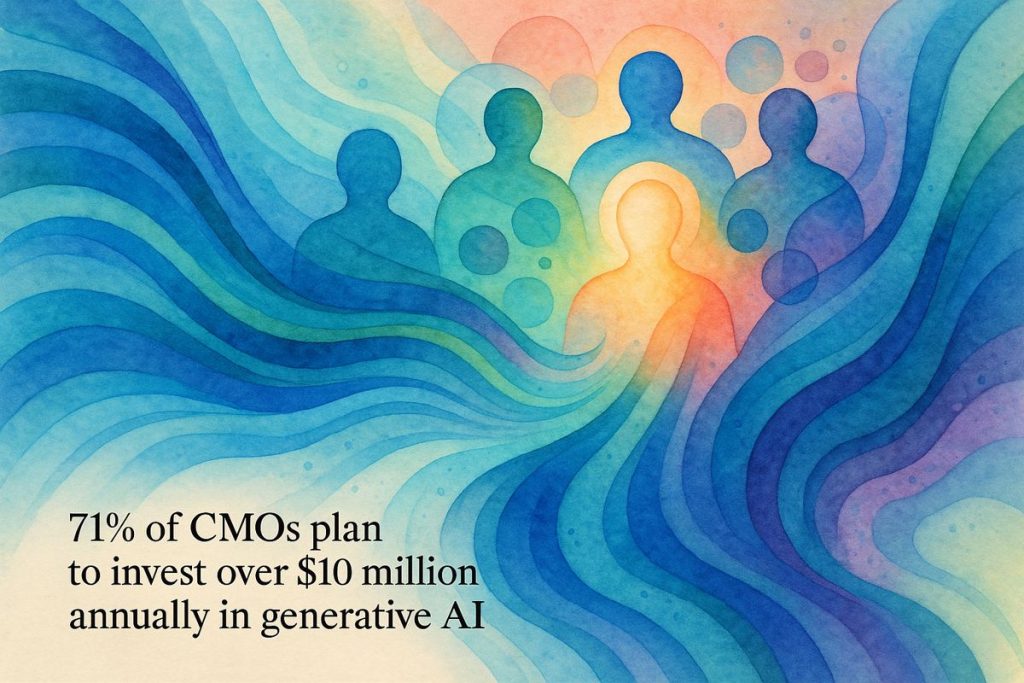CMOs are buzzing with excitement about generative AI, pouring millions into it to make marketing faster, smarter, and more personal. The old worries about privacy and ROI are fading as leaders see real results, like quick campaign launches and better customer engagement. Big tech tools like Salesforce and Adobe are helping marketers create campaigns that almost predict what customers want. But even with all this tech, human oversight still matters to keep things on track and responsible. As AI grows, marketers are eager—sometimes nervously—to shape the future, fueled by big dreams and maybe a bit too much coffee.
What is driving CMOs’ optimism and investment in generative AI for marketing?
CMOs are increasingly optimistic about generative AI, with over 70% planning to invest more than $10 million annually. They see tangible benefits like faster, hyper-personalized campaigns, improved omnichannel engagement, and predictive analytics, while also focusing on responsible AI governance and keeping human oversight central to success.
Smells Like Change Spirit
You know that jittery, not-quite-panicked energy after your third espresso shot? That’s the mood threading through C-suites lately, if the latest BCG survey is to be believed. Once upon a time—not so long ago—marketers muttered about AI with the wariness reserved for pop-ups and GDPR auditors. But now, CMOs from pharma, life sciences, and even less obviously techy empires are humming a different tune. It’s optimism, of all things, that’s in the air. A whiff of it, sharp as ozone before a summer storm.
I had to stop and ask myself: Are we witnessing the dawn of a new marketing zeitgeist, or is this just another over-caffeinated daydream? Because, let’s admit, the last time I felt this kind of industry-wide momentum was when everyone pretended to love QR codes. (I was wrong then. QR codes staged a comeback. Oops.)
From Cautious to Curious—An Evolution in Real Time
Historically, the marketing old guard regarded artificial intelligence as a hyperspectral Rorschach test: really interesting, possibly revealing, but best handled with gloves. Privacy, compliance, ROI—these were the sticks in the spokes. But the BCG numbers say those brakes are off. The curiosity is palpable, almost noisy—like when you walk into a Salesforce conference and half the audience is live-tweeting the keynote.
Let’s get concrete. OmniTalk reports CMOs leaning into the unknown, less out of obligation than genuine intrigue. It’s not blind faith; it’s more the calculated curiosity of a chess grandmaster eyeing the center of the board—move by move, more daring with each play. Curiosity might’ve killed the cat, but in marketing, it just built a better campaign.
I recall a meeting last October at a biotech client’s office—whiteboards bristling with acronyms, someone’s lemon-scented sanitizer stinging my nose. Half the room was skeptical; the other half, buoyed by fresh BCG data, practically buzzed with anticipation. By the end, everyone wanted in. Bam!
Pushing Dollars, Pulling Levers
The numbers, as they say, don’t lie. Over 70% of CMOs plan to invest upwards of $10 million annually into generative AI platforms, according to BestMediaInfo and Exchange4Media. Imagine the whir of servers and the faint, static crackle of all that data being parsed.
But what are they actually getting for their money? This isn’t just speculative moonshotting. Concrete outcomes are stacking up. Omnichannel engagement is being orchestrated with the elegance of a Tchaikovsky ballet—touchpoints sequenced, context understood, customers charmed. Campaigns, once lumbering out of the gate, are now galloping—sometimes launched in less than a week. I once saw a team use Adobe’s RT-CDP to spin up a hyper-personalized campaign by Thursday afternoon; by Friday, engagement metrics had leapt 15%. Not bad for a week’s work.
I’d be lying if I said the speed of it all didn’t make my head spin. There’s a heady cocktail of excitement and, if I’m honest, trepidation too. Are we moving too fast? Or not fast enough?
Tech Titans, Platform Wars, and the Human Touch
You can’t talk enterprise AI without name-dropping the heavyweights. Salesforce Marketing Cloud and Adobe Real-Time CDP are the dueling pianos in this digital jazz lounge. Each promises segmentation that borders on psychic, journey orchestration so smooth it’s almost velvet. Adobe, ever the savvy operator, recently launched a B2B generative AI app for CRM and marketing (TechTarget).
What does that look like in the wild? Predictive analytics that purrs beneath the dashboard, dynamic video content generated on the fly, customer journey maps that seem to preempt your every move—like a palimpsest of intent and action. Chief Marketer chronicles these expanding use cases. The promise isn’t just efficiency; it’s a shot at sustainable growth, perhaps even joy.
Still, I’ve seen perfectly good campaigns undone by a rogue algorithm or a dataset no one bothered to check. Ugh! Lesson learned: the human in the loop is not optional. Even the sleekest AI can’t smell the faint whiff of disaster quite like a seasoned marketer can.
Responsible AI and the Road Not Yet Taken
With great power comes—you guessed it—great governance headaches. CMOs are collaborating with tech partners, hammering out frameworks for responsible AI. Data privacy. Fairness. Accountability. None of it’s glamorous, but as Adobe GenAI and peers set new standards, these unsexy details matter. I can’t help but feel a surge of pride (and a pinch of anxiety) seeing brands lead the charge, not just follow.
So, where does all this leave us? If 2025 is half as eventful as the pundits predict, we’ll see more organizations moving from pilot to full-scale AI integration. The ecosystem’s maturing, the expertise deepening. And me? I’ll be here—watching, learning, occasionally getting it wrong, but always, always reaching for that next cup of coffee…
